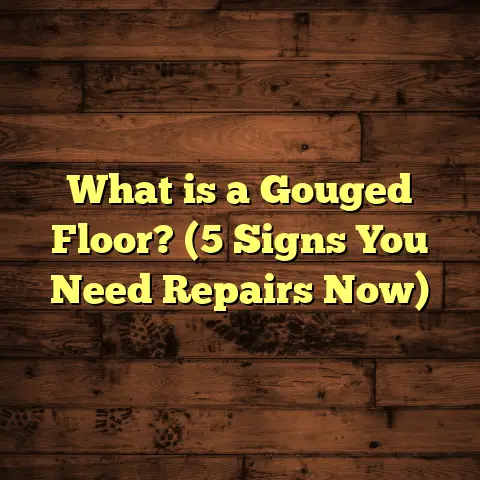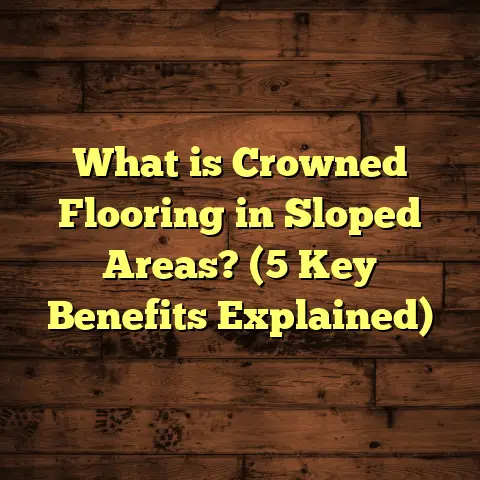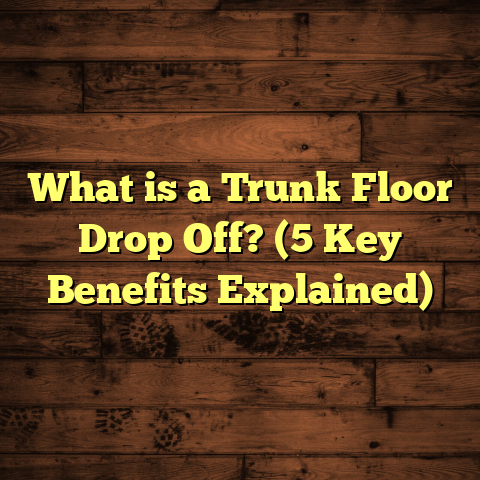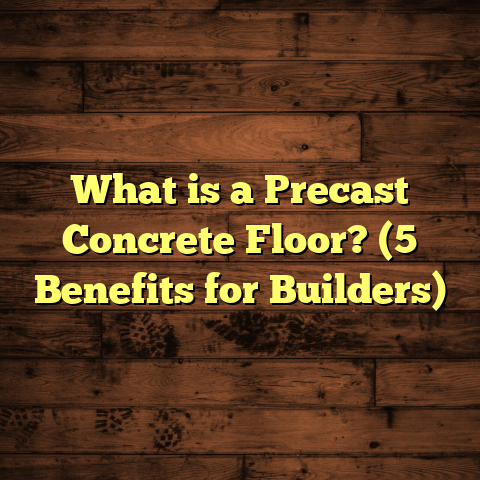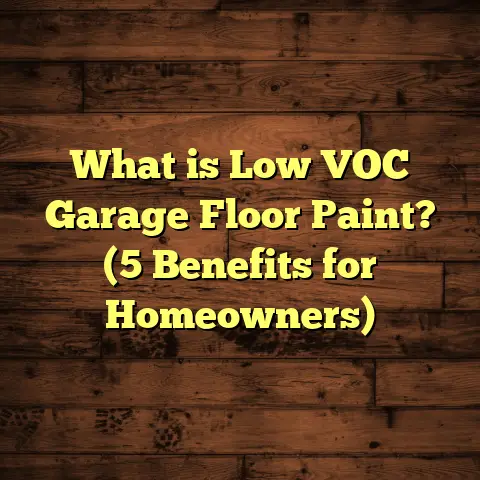What is DIY Friendly Mean for Vinyl Floor? (5 Key Benefits Revealed!)
According to a recent survey by the National Kitchen & Bath Association, over 45% of homeowners took on at least one DIY home improvement project in the past year. I’m part of those statistics myself, especially when it comes to flooring. Vinyl floors have become my favorite choice — mainly because they’re what I call “DIY friendly.” But what does that really mean? How does vinyl flooring become easier for a homeowner like me or you to install ourselves? And why should you care?
I want to share with you everything I’ve learned about DIY-friendly vinyl flooring. From my own experience installing floors in multiple homes, helping friends with their projects, to gathering data from manufacturers and industry experts — I’ll break it down clearly. So pull up a chair, and let’s talk floors.
What is DIY Friendly for Vinyl Flooring?
When I say vinyl flooring is DIY friendly, what I’m referring to is how the product is designed and packaged to make it easier for everyday people — even those without a background in construction — to install without professional help.
Vinyl flooring has evolved a lot over the years. Once upon a time, installing vinyl meant dealing with messy adhesives or glue-down sheets that required precise preparation and special tools. But now, vinyl options come in formats that are much more accessible:
- Click-Lock Vinyl Planks or Tiles: These have interlocking edges that snap together like puzzle pieces. No glue or nails needed.
- Peel-and-Stick Vinyl Tiles: These come with an adhesive backing that you simply peel off before placing the tile.
- Loose Lay Vinyl Sheets: These are thick enough to stay put without glue but flexible enough to cover larger areas smoothly.
This design focus means installation is less intimidating. It also reduces the need for specialized skills or tools.
Breaking Down the Formats
It helps to understand the three main types of vinyl flooring when thinking about DIY friendliness:
- Luxury Vinyl Planks (LVP): These look like hardwood planks but are made of vinyl layers. Most LVPs come with a click-lock system that’s very DIY friendly.
- Luxury Vinyl Tiles (LVT): These mimic stone or ceramic tiles but are vinyl. They can have click-lock or peel-and-stick options.
- Sheet Vinyl: Comes in large rolls or sheets. It’s often glued down but some thick loose-lay options are easier for DIY.
For me, the click-lock LVP and peel-and-stick LVT are the easiest to work with on your own.
Why Has Vinyl Become More DIY-Friendly?
Vinyl is one of the fastest-growing flooring categories, with the global market projected to grow by 7% annually through 2028 (source: Grand View Research). Manufacturers have responded by innovating ways to simplify installation and appeal to homeowners who want control over their projects.
This trend aligns with the rising DIY culture — more people want hands-on involvement with their homes and want to save money by cutting out labor costs where they can.
Five Key Benefits of DIY-Friendly Vinyl Flooring
Ok, now let’s get into what really makes vinyl flooring stand out as DIY friendly. Here are five key benefits that I’ve seen first-hand and verified through research.
1. Simplified Installation Saves Time and Money
I can’t stress this enough: easy installation is the biggest reason I pick vinyl when doing my own flooring projects.
For example, during my last basement renovation, I installed luxury vinyl planks with a click-lock system. The whole process took me about two days for roughly 400 square feet — including prep work like cleaning and leveling.
Why was it so fast? Because there was no glue drying time or grout mixing like you’d have with tile. Each plank snapped into place smoothly, like fitting together puzzle pieces. No nails, no staples, no messy adhesives.
Data backs this up too:
- Industry averages show that DIY-friendly vinyl installations take 20-30% less time than traditional hardwood or tile flooring (source: HomeAdvisor labor data).
- Labor costs can be cut dramatically — professional hardwood installation runs about $4-$8 per square foot labor alone. DIY vinyl lets you avoid that expense entirely if you feel confident.
Another thing I noticed was fewer errors during installation compared to past experiences with laminate or hardwood. The forgiving nature of click-lock systems means small mistakes don’t ruin the entire floor.
Have you ever felt overwhelmed starting a home project because of complicated instructions or tools? That feeling disappears with vinyl floors designed for DIY.
2. Minimal Tools and Equipment Required
Here’s a confession: I’m not a tool hoarder. I don’t want to buy expensive saws or equipment just for one job.
Vinyl’s DIY-friendly designs match my approach perfectly. For most installations, the tools needed are simple:
- A utility knife for cutting planks or tiles
- A tape measure for accurate sizing
- Spacers to maintain expansion gaps around edges
- A rubber mallet or tapping block (sometimes included in flooring kits)
That’s pretty much it.
Some thicker luxury vinyl planks might need a fine-toothed saw for tricky cuts around door frames or vents, but many times a sharp utility knife will do the trick if you score the plank well.
Compare this to hardwood floors that require nail guns, pneumatic staplers, or tile that needs wet saws and grout tools — vinyl keeps things simple.
I remember helping my sister install peel-and-stick vinyl tiles last year in her laundry room. We didn’t use anything except a cleaning cloth for prepping the floor and a utility knife for trimming edges. Total cost for tools? Zero — we already had everything at home.
3. Affordable Without Sacrificing Style or Quality
One of the biggest myths about vinyl flooring is that it looks cheap or low-quality. That couldn’t be further from reality today.
Thanks to advances in printing technology and wear layers, many vinyl products mimic hardwood grains, stone textures, and ceramic tile patterns almost flawlessly.
I personally chose vinyl with a distressed oak look for my kitchen remodel because it gives warmth without breaking the bank.
If we talk numbers, here’s what you can expect based on market research and my own buying experience:
| Flooring Type | Average Price Per Square Foot (Materials Only) |
|---|---|
| DIY-Friendly Luxury Vinyl | $2 – $5 |
| Hardwood | $6 – $12 |
| Laminate | $3 – $7 |
| Ceramic Tile | $5 – $15 |
Sources include FloorTally pricing data and HomeAdvisor reports.
What’s cool is that vinyl lets you achieve high-end looks at budget prices while still being durable and easy to maintain (more on that soon).
When budgeting my projects, I always run numbers through FloorTally — it helps me estimate total costs including materials, labor (if any), waste percentages (usually 5-7% for vinyl), and local price variations.
This clarity helps avoid surprises mid-project — something I learned painfully from past renovations.
4. Durability Suitable for Most Home Areas
Durability is often the question I get asked most: “Will vinyl hold up in high traffic areas like kitchens or entryways?”
From my experience and data I’ve gathered, modern luxury vinyl floors hold up extremely well:
- Most feature wear layers between 6 mils (thousandths of an inch) up to 20+ mils for commercial-grade planks.
- These wear layers resist scratches from pets, furniture movement, and daily activity.
- The waterproof nature of vinyl means spills and moisture won’t warp or damage the floor like hardwood might.
I installed vinyl in my kitchen and entryway four years ago. With two dogs running around and kids dropping food constantly, those floors still look great after regular sweeping and mopping.
Industry tests show high-quality luxury vinyl can last 10-20 years in residential settings before needing replacement — comparable to laminate and some engineered wood floors.
5. Easy Maintenance After Installation
Let me ask: Do you enjoy spending hours scrubbing your floors?
I don’t either.
One of the best perks of vinyl flooring is how little upkeep it demands. No sanding, sealing, or refinishing like wood; no grout cleaning like tile.
My maintenance routine usually looks like this:
- Sweep or vacuum regularly to remove dust and debris
- Damp mop as needed with mild cleaner (nothing harsh)
- Quickly wipe spills before they dry
Vinyl’s waterproof properties make cleaning stress-free — even pet accidents or kitchen spills don’t soak through.
Several friends who installed peel-and-stick vinyl last year all mention how easy cleanup is compared to carpet or hardwood.
My Personal Story Installing Vinyl Floors
Let me take you behind the scenes of one of my favorite projects — installing luxury vinyl plank flooring in my basement.
I was nervous at first because basements tend to be tricky with moisture concerns and uneven concrete slabs. But opting for a click-lock LVP made things manageable.
Step 1: Preparation
I cleaned the concrete floor thoroughly and checked for any bumps or dips using a level. Vinyl needs a flat surface to avoid gaps or buckling later on. For uneven spots, I used a self-leveling compound recommended by the manufacturer.
Step 2: Underlayment
Some LVP products have attached underlayment; mine didn’t, so I rolled out a thin foam underlayment designed for moisture barrier and sound absorption.
Step 3: Installation
Starting along the longest wall, I clicked each plank together row by row. The pieces locked tightly without gaps. Cutting near doorways involved using a utility knife scored on the surface then snapped cleanly.
I worked steadily over two days with breaks — it felt rewarding seeing the floor take shape quickly.
Step 4: Finishing
After installation, I added quarter-round trim around edges to cover expansion gaps and give a polished look.
The result? A warm, waterproof floor perfect for basement use — all done without hiring contractors or renting specialized tools.
Comparing Vinyl’s DIY Friendliness Against Other Flooring Types
If you’re still weighing options, here’s how DIY-friendly vinyl stacks up against other popular floors based on my research:
| Flooring Type | Installation Complexity | Tools Needed | Cost Range Per Sq Ft | Durability (Years) | Maintenance Level | DIY Suitability |
|---|---|---|---|---|---|---|
| Luxury Vinyl Plank/Tile | Easy | Utility knife, spacers | $2 – $5 | 10 – 20 | Low | High |
| Hardwood (Solid) | Moderate-Hard | Nail gun/stapler, saws | $6 – $12 | 20+ | Medium | Low |
| Engineered Hardwood | Moderate | Nail gun/saw | $5 – $10 | 15+ | Medium | Medium-Low |
| Laminate | Moderate | Saw, tapping block | $3 – $7 | 10 – 15 | Medium | Medium |
| Ceramic/Porcelain Tile | Hard | Wet saw, grout tools | $5 – $15 | 20+ | Low | Low |
| Carpet | Easy | Staple gun | $2 – $6 | 5 – 10 | High | Medium |
Vinyl offers a sweet spot where ease of installation meets quality look and durability at an affordable price point.
Common Questions About DIY-Friendly Vinyl Floors
I’ve helped many friends and family members decide if they should tackle their own flooring projects. Here are some questions that come up often:
Can Vinyl Flooring Be Installed Over Existing Floors?
Yes! One of vinyl’s advantages is its ability to be installed over many existing surfaces such as ceramic tile, concrete, or wood — assuming those surfaces are clean, dry, and level.
This means less demolition mess and faster project completion.
Is Subfloor Preparation Important?
Absolutely! Even though vinyl is forgiving compared to hardwood or tile, an uneven subfloor will lead to problems like gaps or uneven wear over time.
Make sure your floor is flat within manufacturer specifications—usually within 3/16” over 10 feet.
How Do You Cut Vinyl Planks?
For most planks, scoring with a sharp utility knife then snapping along the scored line works well. For thicker planks or tiles, you might want a fine-toothed saw such as a jigsaw or miter saw if available.
What Happens If There Are Moisture Issues?
Vinyl is water-resistant but not immune if moisture comes from below. Use a moisture barrier underlayment on concrete slabs prone to dampness to protect your floor’s lifespan.
How Long Does It Take To Install Vinyl Flooring?
For an average room around 200 square feet using click-lock planks, expect anywhere from several hours to two days depending on your pace and skill level.
How FloorTally Helps Me Manage Vinyl Flooring Projects
When managing my flooring projects — whether DIY or contractor-led — accurate budgeting becomes essential. That’s where FloorTally comes in handy for me.
FloorTally is an online tool that lets me input room dimensions, select materials including different types of vinyl flooring, factor in local labor rates (even if I’m doing it myself), waste percentages for cuts/slabs, and more.
What I appreciate most about it:
- It consolidates all calculations into one place instead of hunting around multiple sites.
- It adjusts pricing dynamically based on my location.
- It helps prevent underestimating material needs by including waste factors.
- Gives me confidence in budgeting so no surprise expenses pop up mid-project.
Using FloorTally has saved me time and money planning everything from small laundry rooms up to whole-home renovations.
Tips for Success When Installing DIY-Friendly Vinyl Flooring
I’ve had wins but also learned some lessons installing floors on my own. Here are practical tips if you want your project to go smoothly:
- Prep Thoroughly: Clean and level your subfloor carefully before laying any planks.
- Acclimate Your Flooring: Leave unopened boxes in the room where you’ll install them for at least 48 hours so they adjust to temperature/humidity.
- Plan Your Layout: Measure carefully and plan plank direction — usually parallel to longest wall.
- Leave Expansion Gaps: Flooring expands/contracts slightly; leaving space around edges prevents buckling.
- Use Proper Tools: Invest in good spacers and tapping blocks; they make installation easier.
- Take Your Time: Don’t rush cuts or snapping planks together; precision leads to better results.
- Follow Manufacturer Instructions: Different brands might have specific requirements.
Final Thoughts on DIY-Friendly Vinyl Flooring
If you’ve thought about updating your floors but felt overwhelmed by cost or installation complexity, consider giving DIY-friendly vinyl flooring a shot.
It combines affordability, style options that suit almost any décor, durability that lasts years, plus ease of installation that welcomes beginners and pros alike.
From my own experience installing floors in multiple homes—and helping others—I can say few materials offer this balance as well as modern vinyl does today.
And if budgeting concerns hold you back? Tools like FloorTally simplify planning so your wallet isn’t caught off guard mid-project.
So why not take control of your next floor project? Vinyl makes it possible without stress or huge expenses—and you might just find yourself proud of what your own hands can create!
